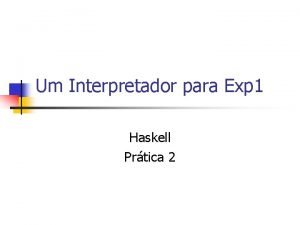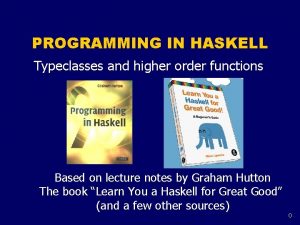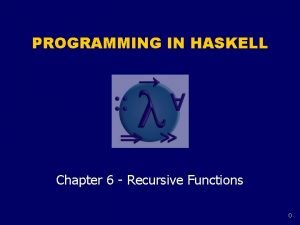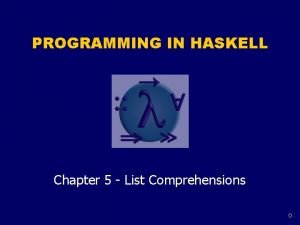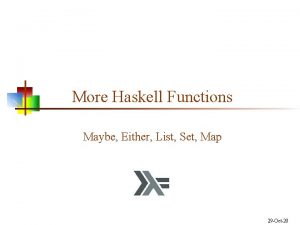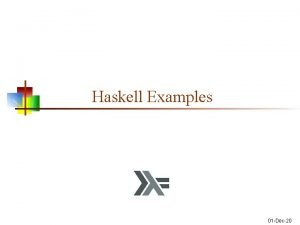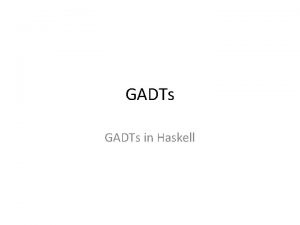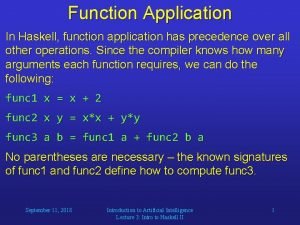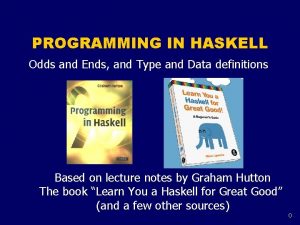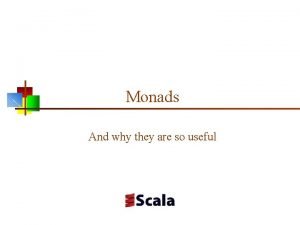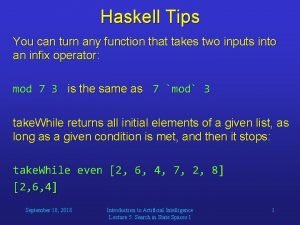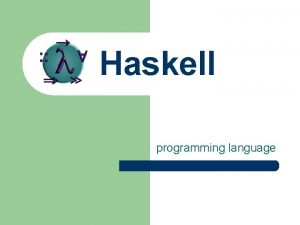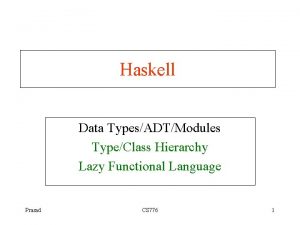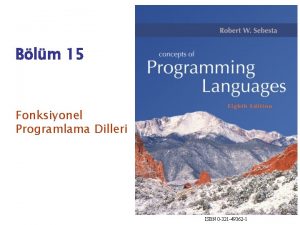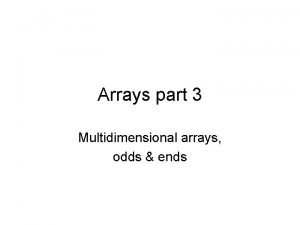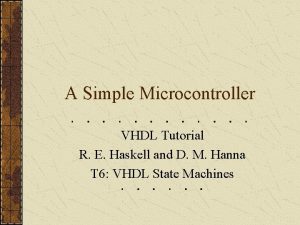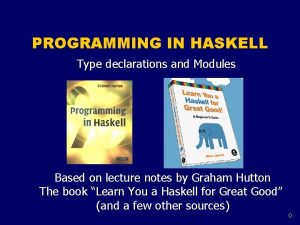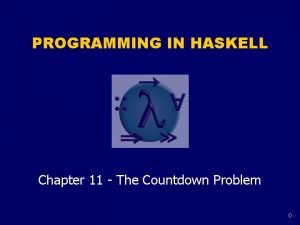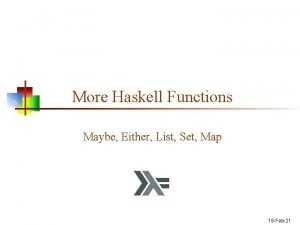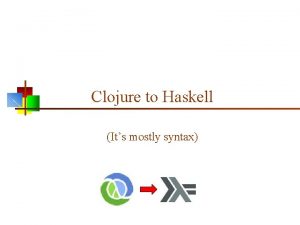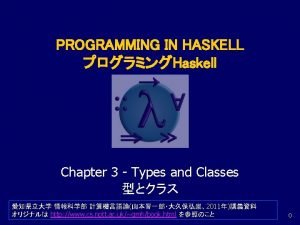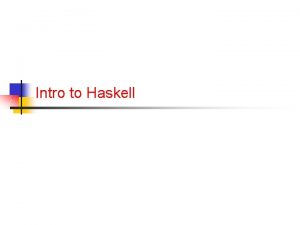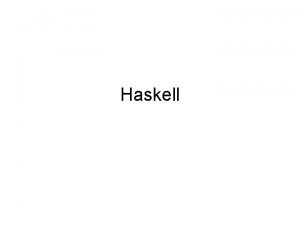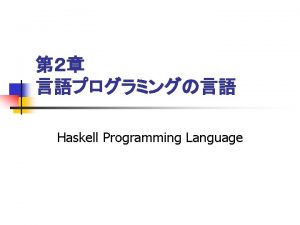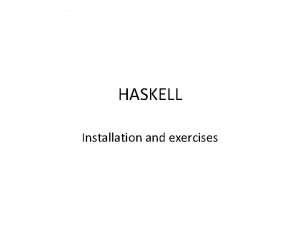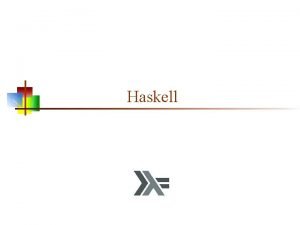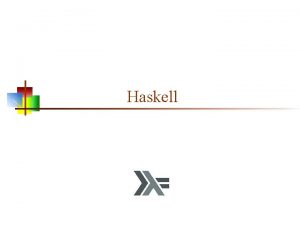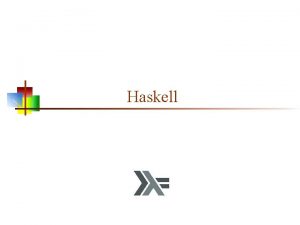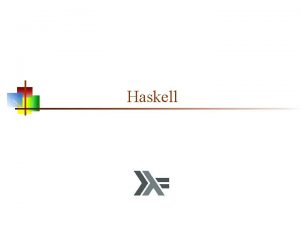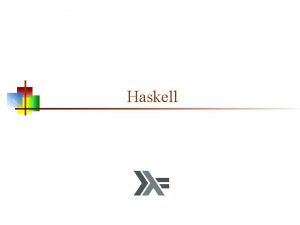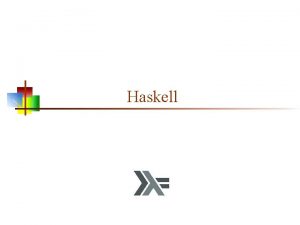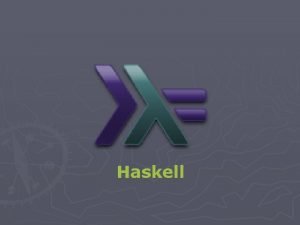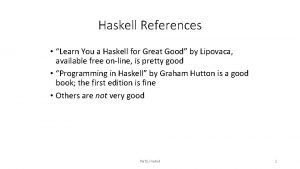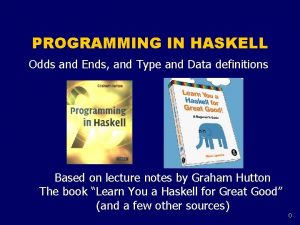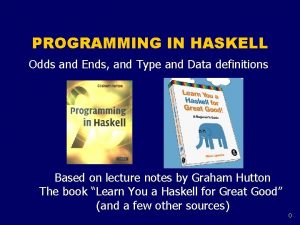Haskell and Haskell VV What is Haskell Haskell






![Other types • Bool, Char • [] are lists – [Bool] or [Char] (String Other types • Bool, Char • [] are lists – [Bool] or [Char] (String](https://slidetodoc.com/presentation_image/9a729fe0492128158c9a2a8294b45cef/image-7.jpg)

![…is polymorphically typed • sort. By : : (a → Bool) → [a] • …is polymorphically typed • sort. By : : (a → Bool) → [a] •](https://slidetodoc.com/presentation_image/9a729fe0492128158c9a2a8294b45cef/image-9.jpg)
![Example: quicksort qsort : : [a] → [a] qsort [] = [] qsort (x: Example: quicksort qsort : : [a] → [a] qsort [] = [] qsort (x:](https://slidetodoc.com/presentation_image/9a729fe0492128158c9a2a8294b45cef/image-10.jpg)

![One more important function • map : : (a → b) → [a] → One more important function • map : : (a → b) → [a] →](https://slidetodoc.com/presentation_image/9a729fe0492128158c9a2a8294b45cef/image-12.jpg)
















- Slides: 28

Haskell and Haskell. VV

What is Haskell? • “Haskell is a polymorphically typed, lazy, pure functional language. ” – www. haskell. org • So what does this mean?

Haskell is…a functional language Imperative (C, C++) Functional (Lisp, ML) • Program is a single sequence of steps function evaluation • Subroutines are called • Sub-expressions are in a specific order evaluated when needed • How to calculate • What is calculated

…a pure functional language • No side effects!

Types in Haskell • num = 2 num : : Int • inc x = 1 + x inc : : Int → Int • add x y = x + y add : : Int → Int • Could be Int → Int or • could be Int → (Int → Int) • a function returning a function!

Types in Haskell • (add 1) : : Int → Int • (add 1) x = 1 + x • inc = add 1 “currying”
![Other types Bool Char are lists Bool or Char String Other types • Bool, Char • [] are lists – [Bool] or [Char] (String](https://slidetodoc.com/presentation_image/9a729fe0492128158c9a2a8294b45cef/image-7.jpg)
Other types • Bool, Char • [] are lists – [Bool] or [Char] (String = [Char]) • (, ) (, , ) and so on are pairs, triples, n-tuples – (Bool , Int) or (Bool , [Char] , Int) • [(Bool , [Char → Int] , [[(Char, Bool)]])]

…is a functional language (2) • Functions are first-order objects! • Functions can be passed as arguments: – sort : : [Int] → [Int] – sort. By : : (Int → Bool) → [Int] – sort. By (<) – sort. By (>) – sort. By (custom. Ordering)
![is polymorphically typed sort By a Bool a …is polymorphically typed • sort. By : : (a → Bool) → [a] •](https://slidetodoc.com/presentation_image/9a729fe0492128158c9a2a8294b45cef/image-9.jpg)
…is polymorphically typed • sort. By : : (a → Bool) → [a] • a can be any type: – sort. By : : (Int → Bool) → [Int] – sort. By : : (Char→Bool) → String →String – sort. By : : ((Int , Int) → Bool) → [(Int , Int)] • sort. By (<) : : [a] → [a] (more or less)
![Example quicksort qsort a a qsort qsort x Example: quicksort qsort : : [a] → [a] qsort [] = [] qsort (x:](https://slidetodoc.com/presentation_image/9a729fe0492128158c9a2a8294b45cef/image-10.jpg)
Example: quicksort qsort : : [a] → [a] qsort [] = [] qsort (x: xs) = (qsort lt) ++ [x] ++ (qsort gt) where lt = filter (<x) xs gt = filter (>x) xs We could also write qsort. By, replacing (<x) with (f x)

Haskell is lazy • eg. head (qsort list) – Only the first element is needed, so the lists gt are never computed! • qsort (x: xs) = (qsort lt) ++ … • = (qsort (l: ls) ++ … … • = ((…(qsort [] ++ [y] ++ …)… • qsort (x: xs) = y
![One more important function map a b a One more important function • map : : (a → b) → [a] →](https://slidetodoc.com/presentation_image/9a729fe0492128158c9a2a8294b45cef/image-12.jpg)
One more important function • map : : (a → b) → [a] → [b] • Applies a function f to every element in a list (or, more generally, any data structure) • eg. map (*2) [1, 2, 3] = [2, 4, 6]

Haskell. VV • mesh, vtx. Label, vtx. Data ← polymorphic • No global state → labels particular to mesh • Query functions like – prev. To : : mesh → vtx. Label – lookup. Data : : mesh → vtx. Label → vtx. Data • Update functions like – set. NB : : mesh → vtx. Label → [vtx. Label] → mesh – lookup. Data : : mesh → (vtx. Label → vtx. Data) → mesh

Haskell. VV • Long operations are clumsy insert. Vertex m p q x = replace. With ( set. NB m x [p, q] ) p q x) q p x)

Haskell. VV • There are ways around this: insert. Vertex m p q x = let m 1 = set. NB m x [p, q] in let m 2 = replace. With m 1 p q x in let m 3 = replace. With m 2 q p x in … • The problem remains: we want sequential operations.

Monads • Mathematical structures offering operations which satisfy certain rules … • Imperative operations are monads!

Monads • provide a way to incorporate ‘side effects’ • eg. I/O operations – put. Str : : String → IO () – get. Str : : IO String • (get. Str >>= str → put. Str str) : : IO () • (do { str ← get. Str; put. Str str; }) : : IO ()

Monads • This looks like imperative code, but… 1. Side-effects are precisely controlled 2. These are first-order objects! – map put. Str [“one” , ”two” , ”three” , …] • is actually a list of I/O operations – [IO ()] , ([IO String] , Bool → IO ()) – sequence [do {str ← get. Str; put. Str str; } , (put. Str “foo”) , …]

Monads and Haskell. VV • use a monad Mesh. Op: prev. To. Op : : vtx. Label→Mesh. Op vtx. Label set. NBOp : : vtx. Label → [vtx. Label] → Mesh. Op () • Mesh. Op is just an operation: • execute. Mesh. Op : : Mesh. Op () → mesh

Example: insert. Vertex : : vtx. Label → Mesh. Op vtx. Label insert. Vertex p q = do lbl ← new. Vertex. Op set. NBOp lbl [p, q] replace. With. Op p q lbl replace. With. Op q p lbl return lbl

Monads and Haskell. VV • Some things are easy (like forall): map some. Operation (list. Vertices mesh) map insert. Vertex (list. Neighbours mesh) • However, many vv programs require two (or more) passes through a forall statement • Hmmm…maybe Haskell can help here?

Delay monads • The Delay monad lets you arbitrarily delay an operation: synchronize ( do { delay a; b; }) ↔ do { b; a; } • A vertex or pair can be dealt with in one go: synchronize (map do. Something (get. Vertices mesh))

Example: delayed. Insert. Vertex : : vtx. Label → Mesh. Op vtx. Label d. Insert. Vertex p q = do lbl ← new. Vertex. Op delay (do set. NBOp lbl [p, q] replace. With. Op p q lbl replace. With. Op q p lbl) return lbl

Example, continued • An operation can then be some. Operation = synchronize ( map handle. One (get. Neighbours mesh)) where handle. One (p, q) = do lbl ← delay. Insert. Vertex p q some. Other. Operation p q • some. Other. Operation uses all of the old neighbourhoods!

Conclusion • What’s good about Haskell (and Haskell. VV? ) – Delayed operations – Strict semantics (no side-effects) – Easier to understand the code – Operations are implementation independent – Haskell code can be as fast as C / C++ – Windowing support, Open. GL libraries, …

Conclusion • What’s bad about Haskell (and Haskell. VV? ) – Haskell is functional and lazy • Expressions are stored until evaluated (or garbage collected) • If you’re not careful, the heap can fill up with unevaluated expressions – Current implementation of vv is slow

What have I left out? • Type classes – define what functions may be applied to a type – for instance, (<) : : a → Bool is only defined for a in class Ord: • (<) : : (Ord a) => a → Bool – Haskell. VV defines classes • • Mesh mesh vtx. Label vtx. Data Mesh. Op op mesh vtx. Label vtx. Data Vector. Space field vector and others

More information • http: //www. haskell. org – Haskell homepage, lots of information, plus compilers, interpreters, etc. • http: //www. cpsc. ucalgary. ca/~laneb/Haskell. VV – Adding my code, will archive this presentation, etc.
 Pair
Pair Higher-order functions haskell
Higher-order functions haskell Haskell wikibook
Haskell wikibook Haskell reverse list recursively
Haskell reverse list recursively List comprehensions haskell
List comprehensions haskell Data map haskell
Data map haskell Haskell linguagem
Haskell linguagem Operadores logicos haskell
Operadores logicos haskell Unwords haskell
Unwords haskell Gadt haskell
Gadt haskell Haskell operator precedence
Haskell operator precedence Curry function haskell
Curry function haskell Haskell visual studio
Haskell visual studio Typed template haskell
Typed template haskell Haskell odds
Haskell odds What is a monad haskell
What is a monad haskell Tips for haskell
Tips for haskell Parsec keybinds
Parsec keybinds Haskell type hierarchy
Haskell type hierarchy Fonksiyonel programlama
Fonksiyonel programlama Haskell two dimensional array
Haskell two dimensional array Haskell microcontroller
Haskell microcontroller Haskell type declaration
Haskell type declaration Functor laws haskell
Functor laws haskell Higher order functions haskell
Higher order functions haskell Haskell exercises solutions
Haskell exercises solutions Either haskell
Either haskell Clojure haskell
Clojure haskell Haskell bool
Haskell bool
